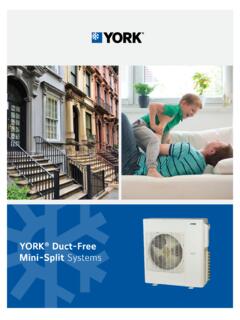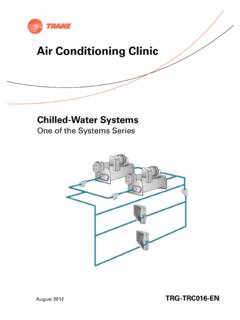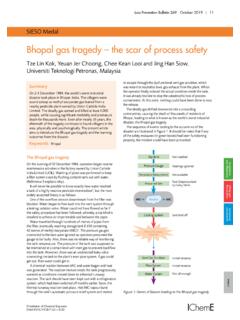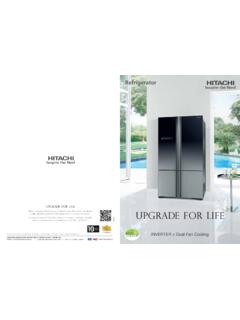Transcription of VACCINE CARRIERS AND COLD BOXES VACCINE CARRIERS …
1 SUPPLY DIVISION VACCINE CARRIERS AND cold BOXES cold CHAIN SUPPORT PACKAGE PROCUREMENT GUIDELINES VACCINE CARRIERS AND cold BOXES Procurement Guidelines VACCINE CARRIERS and cold BOXES Key information for UNICEF staff and partners, ensuring the effective and efficient procurement of cold Chain equipment. This module gives guidance to the procurement of VACCINE CARRIERS and cold BOXES for VACCINE distribution. Always make sure that you have the latest version of this document by checking the CCSP website. Document Update: January 11, 2021 Suggestions and feedback: Contents 1 INTRODUCTION TO VACCINE CARRIERS AND cold BOXES .. 1 2 TERMINOLOGY .. 2 3 CHOICE OF EQUIPMENT .. 2 4 COOLANT PACKS .. 2 USING COOLANT 2 5 FREEZE-PREVENTATIVE VACCINE CARRIERS AND cold BOXES .. 3 6 VACCINE CARRIERS AND cold BOXES SUPPLIED BY UNICEF 5 7 HOW TO ORDER.
2 6 THE ORDERING PROCESS .. 6 CONSIDERATIONS FOR COUNTRY OFFICES .. 6 DELIVERY LEAD TIME .. 6 ANNEX 1: ADDITIONAL RESOURCES .. 7 ANNEX 2: RECORD OF REVISIONS .. 8 Acronyms CB cold Box CCSP cold Chain Support Package CO Country Office DOA Direct Order Arrangement FP Freeze-Preventative FPCB Freeze-Preventative cold Box FPVC Freeze-Preventative VACCINE carrier LTA Long Term Arrangement OPV Oral Polio VACCINE PCM Phase Change Material PHC Primary Health Care PQS Performance Quality and Safety PS Procurement Services SD Supply Division (UNICEF) UIFP User-Independent Freeze-Preventative VC VACCINE carrier VVM VACCINE Vial Monitor WHO World Health Organization Procurement Guidelines: VACCINE CARRIERS and cold BOXES Page 1 1 Introduction to VACCINE CARRIERS and cold BOXES cold BOXES , VACCINE CARRIERS and coolant packs are used for keeping vaccines cold during transportation.
3 In comparison with cold BOXES , VACCINE CARRIERS have a smaller volume, suitable for use by health workers during immunization campaigns and out-reach services. As these are passive devices, coolant packs are used as accessories for both cold BOXES and VACCINE CARRIERS to provide the cooling capacity for a limited time period. The products are, in principle, simple. Overall, there is a low level of skill required to use them. Coolant packs are put into the BOXES / CARRIERS packed with the VACCINE vials, in accordance with the instructions provided with the product (drawings inside the cover of the box/ carrier ). All VACCINE CARRIERS and cold BOXES are supplied with one set of coolant pack required as standard. cold BOXES are insulated containers which are lined with coolant packs to keep vaccines and diluents cold during transportation and/or short period storage.
4 cold BOXES are used to collect and transport VACCINE supplies from one VACCINE store to another, and from VACCINE stores to health facilities. These products are also used to temporarily store vaccines when the refrigerator is out of order or being defrosted. The VACCINE storage capacity of cold BOXES is between 5 and 25 litres. cold BOXES can be grouped into two range categories: 1. Short range: With a minimum cold life of 48 hours at 43 C ambient temperature. 2. Long range: With a minimum cold life of 96 hours at 43 C ambient temperature. VACCINE CARRIERS are insulated containers that, when lined with coolant packs, keep vaccines and diluents cold during transportation. VACCINE CARRIERS are smaller than cold BOXES and are easier to carry when walking. These products are used for transporting vaccines from health facilities with refrigeration to outreach immunization sessions where refrigeration and ice are not available.
5 VACCINE CARRIERS are typically carried by a single health worker travelling on foot or by other means, where the combined journey time and immunization activity may range from a few hours to a whole day. The VACCINE storage capacity of VACCINE CARRIERS is between to litres. VACCINE CARRIERS can be grouped into two range categories: 1. Short range: With a minimum cold life of 15 hours at 43 C ambient temperature. 2. Long range: With a minimum cold life of 30 hours at 43 C ambient temperature. All pre-qualified VACCINE CARRIERS and cold BOXES are listed on the WHO website for pre-qualified equipment. UNICEF/NYHQ2011-2454/Sokol Carrying a ' cold box' filled with polio vaccines, a health worker passes other travelers on a dirt road as he journeys to Pakur Village, in Unity State. cold BOXES play a critical role in preserving the cold Chain , the series of temperature controls required to maintain VACCINE potency from manufacture through inoculation.
6 Procurement Guidelines: VACCINE CARRIERS and cold BOXES Page 2 2 Terminology cold life: The empty container is stabilized at +43 C and loaded with icepacks. cold life is measured from the moment when the container lid is closed until the temperature of the warmest point in the VACCINE storage compartment first reaches +10 C, at a constant ambient temperature of +43 C. Cool life: The empty container is stabilized at +43 C and loaded with coolant packs which have been stabilized at + 5 C for a minimum of 24 hours. Cool life is measured from the moment when the container is closed, until the temperature of the warmest point inside the VACCINE storage compartment first reaches +20 C, at a constant ambient temperature of +43 C. Coolant pack: Coolant packs are flat, square plastic bottles that are filled with water and cooled.
7 Coolant packs are lined inside VACCINE CARRIERS or cold BOXES to keep the vaccines cool during the transport. Ice pack: A water-pack frozen to a temperature between -5 C and -20 C before use. Icepacks are used frozen for the transport of oral polio VACCINE (OPV) and used conditioned (see procedure for conditioning further down) for the transport of all other vaccines. Temperature Stability: The VACCINE CARRIERS and cold BOXES are tested for temperature stability at ambient temperatures of 43 C and -20 C in WHO-accredited laboratories to ensure that at field conditions the equipment will perform optimally. The frequency and duration of door openings will raise the internal temperature of the BOXES and will shorten the cold life and Cool life. 3 Choice of Equipment The most suitable cold BOXES & VACCINE CARRIERS for addressing the transport needs can be determined by: The VACCINE storage capacity needed; The cold life needed, that is, the longest time that VACCINE will be stored in the box; The weight and the dimensions of the box, which depends on the mode of transport, whether by motor vehicle, bicycle, or hand; and Number and type of coolant packs compatible with cold box to realize its rated cold life.
8 4 Coolant Packs Using Coolant Packs Coolant-packs can be prepared for use in four different ways as follows; frozen icepacks, conditioned icepacks, cool water packs, warm water packs. Icepacks (frozen coolant packs) are used only for OPVs and similar vaccines, which are not damaged by freezing. In order to protect freeze-sensitive vaccines, frozen icepacks should be conditioned before they are lined in non-freeze preventative CBs or VCs. Conditioned icepacks or cool water packs between + 2 C to +8 C are used to keep vaccines cool inside the non-freeze preventative VACCINE CARRIERS or cold BOXES . Warm water-packs are used to protect freeze-sensitive vaccines in countries where temperatures are frequently below 0 C and heated vehicles are not available. UNICEF/NYHQ2012-1311/Zaidi Health Workers travel by boat across the Indus River to remote Shah Nawaz Village in Shikarpur District in Sindh Province.
9 They are on their way to vaccinate children under age five in the flood-affected village. One of the women carries an insulated cold box. Procurement Guidelines: VACCINE CARRIERS and cold BOXES Page 3 The number and type of coolant packs required for a cold box or VACCINE carrier varies according to the type of cold box or VACCINE carrier . Note that one set of coolant packs is provided with each procured cold box or VACCINE carrier (both standard and freeze-preventative types). FFVCs and FFCBs should be used with frozen coolant packs without conditioning whereas standard VC and CB models should be used with conditioned coolant packs. 5 Freeze-Preventative VACCINE CARRIERS and cold BOXES In recent years manufacturers have started to develop Freeze-Preventative VACCINE CARRIERS (FPVCs) and Freeze-Preventative cold BOXES (FPCBs) to reduce the risk of VACCINE freezing during transport and allow health staff to use these products without the need to pre-condition coolant packs.
10 In order to prevent direct contact between vaccines and coolant packs, these FPVCs/FPCBs are designed to have an insulated barrier lining, which separates the VACCINE storage compartment from the coolant packs. Therefore, compared to standard VC and CB models, FPVC and FPCBs have higher weights and volumes due to these integrated design elements which reduce the risk of freezing for vaccines. On contrary to standard VCs and CBs, FFPCs and FPCBs should be used with frozen coolant packs without conditioning. FFVCs & FFCBs should not be used with cool water packs or conditioned ice packs, as the use of cool water packs will severely reduce the FPVC & FPCB's capacity to keep the vaccines cold . If conditioned ice packs are placed into freeze-preventive equipment, it may take longer to get cold , and may not stay cold as long. 1 Strong consideration should therefore be given to avoid in-country risk of users inadvertently using cool water packs or conditioned ice packs with FPVCs or FPCBs.
















